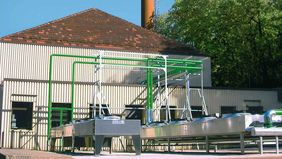
STEAG harnessing waste heat from mine water for district heating supply
Camphausen/Sulzbach/Saarbrücken. STEAG New Energies GmbH, a Saarbrücken-based subsidiary of the Essen energy company STEAG GmbH, is planning an innovative CHP facility at the site of the former Camphausen underground coal mine which will enable the waste heat from mine water to be used for the Sulzbach municipal district heating supply. The resource and environmentally friendly concept received funding from the Federal Network Agency in a tendering process in December.
The funding commitment for the Camphausen project means that STEAG has again succeeded in winning a tender for a CHP project, as it already had in 2019 and 2020. In accordance with the Combined Heat and Power Act (KWKG), the Federal Network Agency (BNetzA) conducts tender procedures for funding twice a year.
“We are delighted at this renewed success, especially since the most recent call for tenders in December concerned innovative CHP energy systems that are particularly demanding in terms of technology and energy efficiency,” says Dr. Markus Laukamp, Managing Director at STEAG New Energies.
STEAG harnessing waste heat from mine water
An innovative CHP facility comprises three well-matched components: a conventional CHP unit, a renewable heat source and an electric heat generator. “In the case of the Camphausen facility, the renewable heat source is the mine water, which still has to be pumped out of the mine to the surface on a never-ending basis even after the coal mine has been shut down,” explains Christoph Traum, who is responsible for the project at STEAG New Energies.
The water, which would otherwise be discharged unused into a nearby river, has a temperature of 36 degrees Celsius, and the heat contained in the water can be recovered for use in supplying heat by means of a heat pump. “This means we save natural gas and so protect the environment and the climate – to a considerable extent, too, because we’re talking here about around 6,300 metric tons of CO2 emissions being avoided every year,” Christoph Traum points out. That is roughly equivalent to the CO2 emissions of a medium-sized car driven a good 44.5 million kilometers or 1,100 times around the globe, he explains.
At the same time, the existing CHP unit will be modernized for use in the innovative CHP facility and expanded to include a heat accumulator and a power-to-heat system. The Camphausen district heating supply will be converted from steam to hot water as part of the modernization, significantly reducing its heat losses in the future. Taken all together, these measures will increase the cost-effectiveness and resource efficiency of the overall system quite considerably.
Protecting the climate by firing mine gas
On top of that comes the fact that the conventional CHP unit can be fired with mine gas. Mine gas continues to be produced even after coal mining has come to an end, and it is particularly harmful to the climate because of its high methane content. “Using mine gas as a fuel and firing it also enables us to contribute to protecting the climate, because its burning reduces the impact on the climate by a factor of 21,” project manager Christoph Traum points out. Recovering energy from mine gas thus also constitutes an important contribution to climate protection, he says.
This ultimately benefits the STEAG New Energies customers like the Sulzbach municipal utility: “Because the heat we supply is largely free of CO2, the costs are significantly lower than with other forms of heat supply. This is due to the CO2 levy introduced at the beginning of the year,” Christoph Traum explains. The innovative CHP solution in Camphausen therefore not only protects the climate, but also means the customers save money.
Camphausen: Successful model for conservation of resources and structural change
In this respect, the Camphausen project is a success in more ways than one – not just for STEAG and its customers, but also for the region as a whole: “We are harnessing the knock-on effects of mining, doing good for the environment and the climate, and also moving structural change a step forward by applying the mining legacy of the Saarland in future energy solutions,” Markus Laukamp emphasizes. The Camphausen project therefore points the way forward for heat supply in the region.
